Blog, potato (Solanum tuberosum)
The Practicality of Diploid Potatoes in North America
The domesticated potato (Solanum tuberosum) is divided into two major groups based on the number of sets of chromosomes: tetraploids, with four sets of chromosomes, and diploids, with two sets of chromosomes. The common potato of commerce is tetraploid. There are also hundreds, if not thousands, of varieties of diploid potatoes, but they are mostly grown at relatively small scale in the Andes. While diploid potatoes are recognizably potatoes and are included in the same species as the common tetraploid varieties, they have enough differences that it would almost be better to think of them as a different crop. I get a lot of questions about the practicality of growing diploids and whether or not there are varieties that perform more like familiar tetraploid potatoes, so the purpose of this post is to answer those questions and discuss the circumstances under which diploid potatoes can be a practical crop in North America. In this post, I am not considering the value of diploid potatoes for breeding, which is considerable, just their value as a food crop.
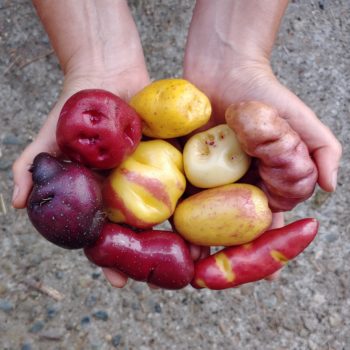
First, let’s consider the major differences between diploid and tetraploid potatoes:
- Diploids have a lower yield, with very few exceptions.
- Diploids have smaller tubers.
- Diploids are often short day tuberizers.
- Many diploids have no or very short tuber dormancy.
- Diploids have different flavor and texture combinations than those commonly found in tetraploids.
I guess we need to think about what it means to be practical. If diploids yield less, are they practical? If you grow a tetraploid potato, you are going to get more food from the same amount of space and effort. That certainly makes diploids sound impractical. On the other hand, if you use the same space to grow tomatoes or cucumbers or lettuce, you are going to produce a lot less calories for the same effort, so maybe those crops aren’t practical either. Of course, a potato makes a poor substitute for a cucumber, which is why we grow more than one crop. So, the next question is: are there enough differences in the culinary properties between diploid and tetraploid potatoes to justify growing diploids? The answer to that question is going to be subjective. I think that the flavor of the best diploid potatoes is unparalleled in tetraploids, so I will happily devote space to growing them, even though they produce less food. Because of that, I generally only keep the very best diploids. An average diploid could be a very fine potato, but an average tetraploid is going to taste similar and produce more. So, for me, diploids have to have better flavor, and possibly appearance, than tetraploids.
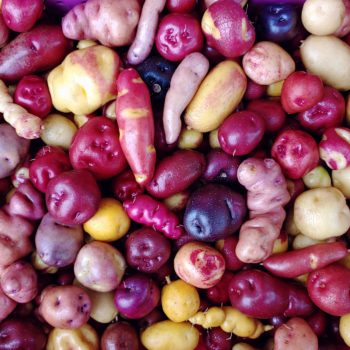
Diploids can be divided into two groups based on dormancy. Low dormancy diploids were selected to grow in the lower, warmer elevations of the Andes where there are no hard frosts. They are grown back to back, replanting some of the tubers at the time when they are harvested. Low dormancy diploids are difficult to store, since the tubers begin sprouting again soon after they mature. They are meant to be stored in the ground. High dormancy diploids are grown at the higher elevations of potato cultivation and often have some frost resistance. They have dormancy similar to common tetraploid potatoes, so they can be stored through the winter. In both groups, the yields tend to be about half that of tetraploid potatoes and the tubers are smaller, rarely exceeding three inches.
One of the major obstacles with diploids is that many of them are short day tuberizers: they don’t begin to form tubers until fall. That is not really a practical feature anywhere in North America, although you can live with it in areas with a long, mild autumn. The good news is that a reasonable percentage of diploid potatoes grown from seed are day neutral. So, you just need to select the plants that tuberize during summer or early fall and you have worked around that problem.
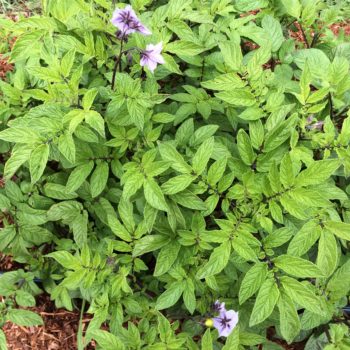
Diploids may be more practical in some climates than others. For example, if you live in an area that is frost free or nearly so, you may find advantages in growing diploid potatoes that have no dormancy. This frees you up from needing to manage storage and time plantings. Low dormancy diploids typically begin sprouting again soon after they mature. You can harvest on demand, leaving some tubers in the ground to grow in succession. Of course, this will ultimately lead you to the downfall of many potato plots: the accumulation of pests and diseases. So, some rotation is advisable, but you can still lift the potatoes and immediately replant them in fresh soil. In a frost free climate, you can get three or maybe even four crops a year back-to-back. These circumstances actually give diploids a yield advantage over tetraploid potatoes.
Low dormancy diploid potatoes also have some of the greatest heat tolerance of any domesticated potatoes. If you grow in a climate that is just a little too hot for tetraploid potatoes, you might find that diploids produce better. If you also have freezing winter temperatures though, storing these low dormancy potatoes can be a challenge. If your winters don’t freeze the soil to significant depth, you can store them in the ground. Then you just need to dig up the remainder and replant in the spring. You can do this in most maritime climates and probably in much of the Southeast. There are probably parts of Hawaii, coastal California, the Southeast, and Puerto Rico, where diploid potatoes could be better producers than tetraploids. The trick will be learning how to grow them well in your specific climate, since the lessons learned growing tetraploid potatoes don’t always apply.
As for the Pacific Northwest, are diploids a practical choice? If your main concern is yield, probably not. You can get two or even three crops from low dormancy diploids in the milder areas west of the Cascades and you can store the tubers in the ground if your water table isn’t too high, but you still aren’t going to beat the yields that you would get from growing a single crop of late tetraploid varieties in this climate. So, growing diploids in the PNW is more a matter of what kinds of potatoes you want to eat. In this region, the main reason to grow diploids is for their excellent flavor and vivid colors. If you value those things over yield, then you will always be happy growing diploids.
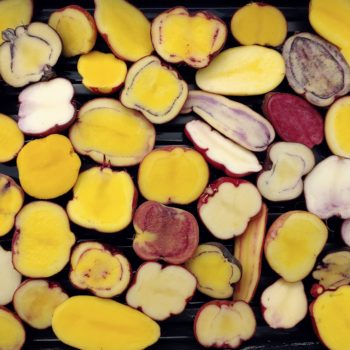
If you are a farmer, you might have a hard time selling diploid potatoes. Or you might not. This depends on the kind of customers you have. I generally hear good reports from people who sell at farmers markets in or near large cities. If you sell in a rural area, you may not have much luck moving diploid potatoes. I know that they have typically attracted little interest in my rural county. People have a tendency to judge potatoes based on tuber size. Big potatoes are good. Small potatoes… well, we use “small potatoes” as a metaphor for things that are unimpressive, which tells you something. (Incidentally, when I was considering names for this business, one of the candidates was “Small Potatoes.”) To overcome this, you need to spend some time educating your customers about the differences.
There are areas of the USA where diploids really don’t do well. Where the growing season is short and the winter is long and freezing, it can be virtually impossible to store low dormancy diploids and you will probably only be able to grow one crop, which means that you are going to harvest a lot less than you would with an early tetraploid variety. High dormancy diploids will store through the winter, but you still have the yield problem. In areas of the East where both late blight and Colorado potato beetle pressure is high, people usually report poor results with diploids of both groups.
There is no clear answer about the practicality of growing diploids in the USA, but I do think it is best if you regard them as a different crop, with its own advantages and limitations. In some areas of the country, they may have great unexplored potential. In most places, they will never equal the common tetraploid potato in yield or tuber size, although there are ongoing efforts to breed high yielding diploids that can compete with tetraploids as commodity class potatoes. I have a feeling that we will be waiting for quite some time to see parity though. In the meantime, diploid potatoes will remain a culinary curiosity, more likely to be grown in home gardens than monocrop fields.

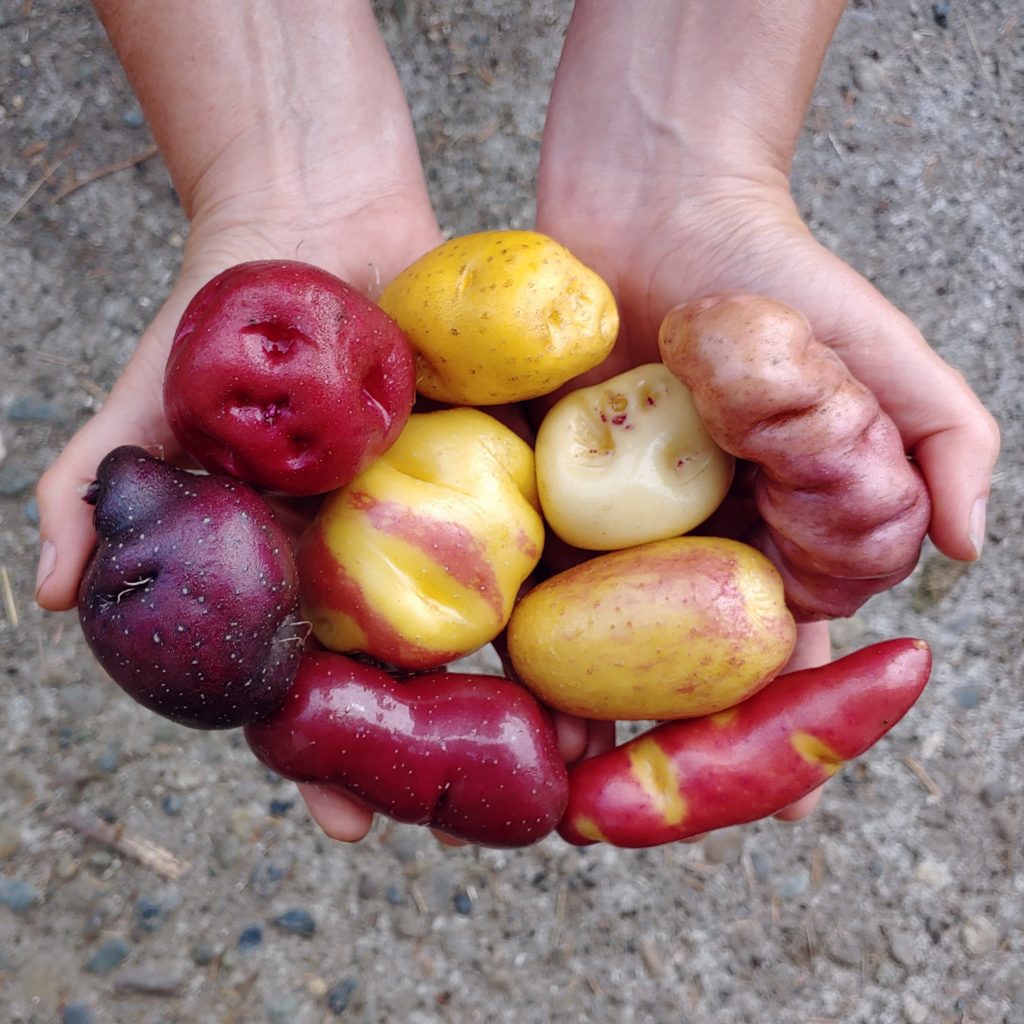
Diploid only refers to ploidy. You have described South American land race germplasm that happens to be diploid. Diploids can also be created from temperate zone tetraploid cultivars. They are being developed for improved breeding efficiency and are quite different from land races.
That’s a very good point. I should have clarified that I was speaking of Andean diploids, but most regular readers will take that for granted. Advanced/modern diploid and dihaploid varieties aren’t really available commercially and I don’t offer any, although I do grow a few from the potato genebank. It is always nice to have the experts chime in! There is a lot of exciting work going on in diploid potato breeding.
When you say that diploids have lower yield, do you mean on a per-plant basis, or a per-row-foot basis?
Yes.
While diploid plants can be smaller, they usually take up about the same amount of row space, so per plant, or per unit of area, you get lower yield. There is some room to optimize this by selecting varieties with a better ratio of yield to aerial plant size, but I don’t think you will get to parity. In some cases, you can get fairly close. I grow a variety called Qoyllu that has small plants and can be grown on an eight inch spacing. That will produce a result a lot closer to typical tetraploid yields.
What would your planting schedule look like for low dormancy diploids west of the cascades? We live on an island in the Puget Sound, and I’m curious about getting multiple harvests per year…especially if they would be very early. Do the plants still senesce, or how do you know when to harvest potatoes from them? How are they typically stored so you can eat them? Do you just have to keep breaking off sprouts? How do the plants act if tubers are stored in the ground over winter? Would there be any useful growth under a cloche, or is there just not enough light here during the winter?
Sorry for the onslaught of questions!